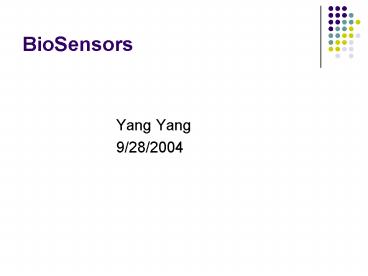BioSensors - PowerPoint PPT Presentation
1 / 20
Title:
BioSensors
Description:
by modifying swelling properties of the. coating material, by changing the dimension ... Cantilever Array Based Nanotechnology Olfactory Sensors (NOSE) ... – PowerPoint PPT presentation
Number of Views:2054
Avg rating:3.0/5.0
Title: BioSensors
1
BioSensors
- Yang Yang
- 9/28/2004
2
Outlines
BioMEMS Enzyme-coated carbon nanotubes Microcant
ilever biosensor with environmentally responsive
hydrogel Cantilever array based nanotechnology
olfactory sensors Conclusion
3
BioMEMS
Inetegration of life science/biomedical Discipline
s with micro- and nano- Scale systems
and materials.
4
BioMEMS
Materials used for fabrication
Biosensors
Biosensors are analytical devices that combine a
biologically sensitive Element with a physical or
chemical transducer to selectively and
quan- Titatively detect the presence of specific
compounds in a given external environment.
5
BioMEMS
BiosensorMechanical detection
Mass mode cantilever sensor
Stress mode cantilever sensor
6
BioMEMS
Biosensor-- Electrical detection
Potentio, measures the potential at an electrode
in reference to another
Ampero, monitors formation of H in a redox
process
Conducto, measures the changes in Electrical
impedance between 2 electrodes.
Both ampero- and potentio- need reference
electrodes, which makes the fabrication difficult.
Conducto- does not.
7
BioMEMS
Biosensor-- Optical detection
Based on fluorescence or chemiluminescence.
Fluorescence- fluorescent markers emits light
at specific wavelengths,
thus any change in
optical signal indicates
a binding reaction. Chemiluminescence- light is
generated by the
release of energy as a result of a
chemical reaction.
Cited paper
R. Bashir, BioMEMS state-of-the-art in
detection, opportunities and prospects, Advanced
drug delivery reviews, 56 (2004) 1565-1586
8
Enzyme-Coated Carbon Nanotubes
Manufacturing method
9
Enzyme-Coated Carbon Nanotubes
Effects of GOx immobilization
- After immobilization
- AFM height 5 nm ? 8 nm
- 1 GOx molecule per 12 nm
- Conductance of SWNT decreases
- significantly (black ? cyan)
4. pH dependent
bare SWNT
50 GOx molecules on SWNT
10
Enzyme-Coated Carbon Nanotubes
Effects of GOx immobilization
Pros
5. Glucose sensitive.
- Very sensitive to testing entities.
- Excellent nanosize pH sensor
- can measure pH as low as 0.1
- Enzyme detector
- can measure the enzymatic
- activity of a single redox enzyme.
Cited paper
K. Besteman, et al, Enzyme-coated Carbon
nanotubes as single- Molecule biosensors, vol. 3,
no. 6 ,727-730, 2003
11
Microcantilever Biosensor withEnvironmentally
Responsive Hydrogel
Method of fabrication
Released cantilever
Oxide layer
Silicon layer
Silicon-On Insulator (SOI) wafer
Buried silicon layer
Etch using photoresist mask
Soaked in organosilane gaining bonding
between polymers and cantilever
Soaked in hydro- Fluoric acid to etch Off all
oxide
Etch out 3 layers at selected locations
Dry etch out oxide on substrate
Grown oxide
Use tetramethylammonium hydroxide to etch the
silicon substrate and to form the Cantilever/oxid
e composite
Precise photo-etching to form coated cantilever
Cantilever/oxide combo
12
Microcantilever Biosensor withEnvironmentally
Responsive Hydrogel
Testing results
Hydrogel film capable of Sensing the change in
pH Sensitivity of pH is Per 1 nm bending
Increasing pH path
Decreasing pH path
13
Microcantilever Biosensor withEnvironmentally
Responsive Hydrogel
Pros
- Very sensitive to changes in pH
- Response features can be controlled
- by modifying swelling properties of the
- coating material, by changing the dimension
- of cantilever, etc
- Can be testing sample specific by bonding
- other environmentally responsive hydrogels.
Cited paper
J.Z. Hilt, et al, Ultrasensitive biomems sensors
based on microcantilevers Patterned with
environmentally responsive hydrogels, Biomedical
microdevice 53, 177-184, 2003
14
Cantilever Array Based Nanotechnology Olfactory
Sensors (NOSE)
Cantilever sensors array and polymer coatings
Cantilever length
thickness
width
15
Cantilever Array Based Nanotechnology Olfactory
Sensors (NOSE)
Schematic setup
16
Cantilever Array Based Nanotechnology Olfactory
Sensors (NOSE)
Data acquisition
Signal magnitude for each one of the 8
cantilevers at 5 acquisition Instants with the
injection of etha-nol
17
Cantilever Array Based Nanotechnology Olfactory
Sensors (NOSE)
Data processing (Principal Compo- nents Analysis)
PCA is a statistical method that rotates a data
set such that the max. variability is visible and
the Most important gradients are Identifiedmore.
18
Cantilever Array Based Nanotechnology Olfactory
Sensors (NOSE)
Differential measurement in liquids
Noises occur in liquid envir. measurement changes
in pH Ion concentration temperature and
etc.
19
Cantilever Array Based Nanotechnology Olfactory
Sensors (NOSE)
Pros and Cons
Reference sensors can be used for differential
measurements It can be used in various
media High sensitivity over a wide range of
operating temperatures It can be integrated
into other systems Relatively long response
time.
Cited paper
M.K. Baller, et al, A cantilever array-based
artificial nose, Ultramicroscopy, 82 (2000) 1-9
20
Conclusion
- Biosensors are very small, very sensitive and
- can be transplanted to human body
- Dramatically improve efficiency in drug discovery
research - Multidisciplinary































